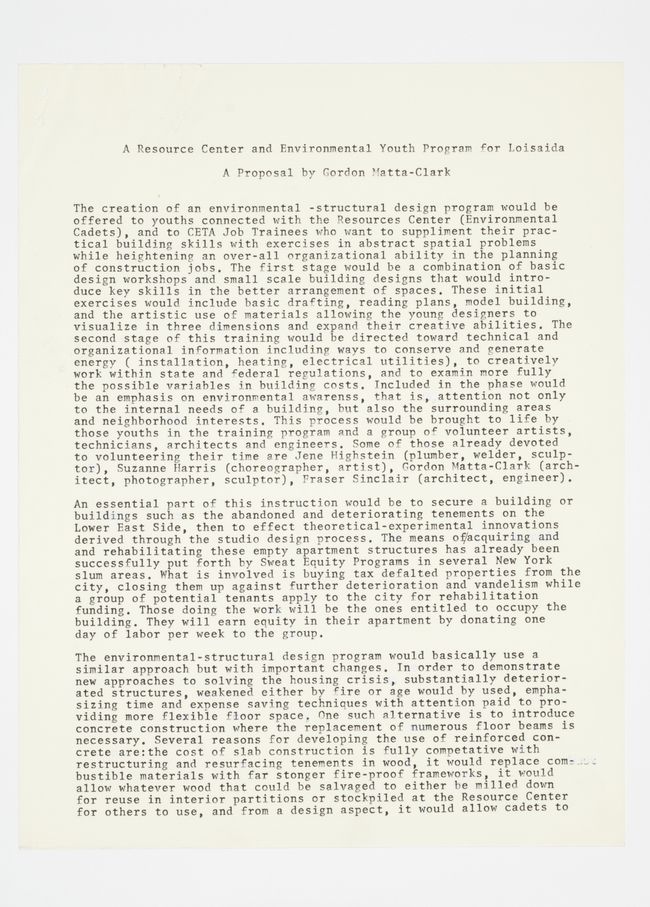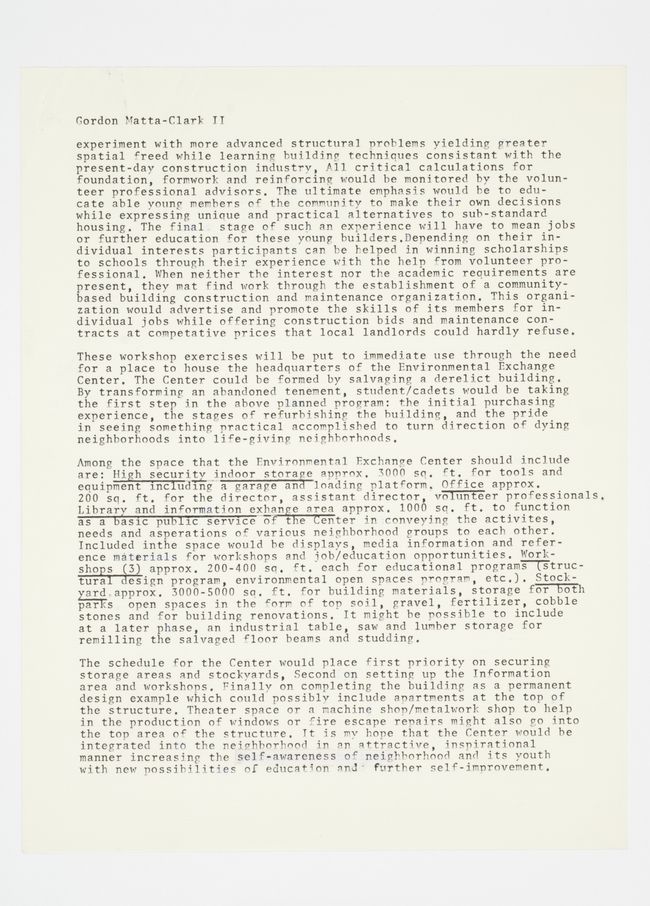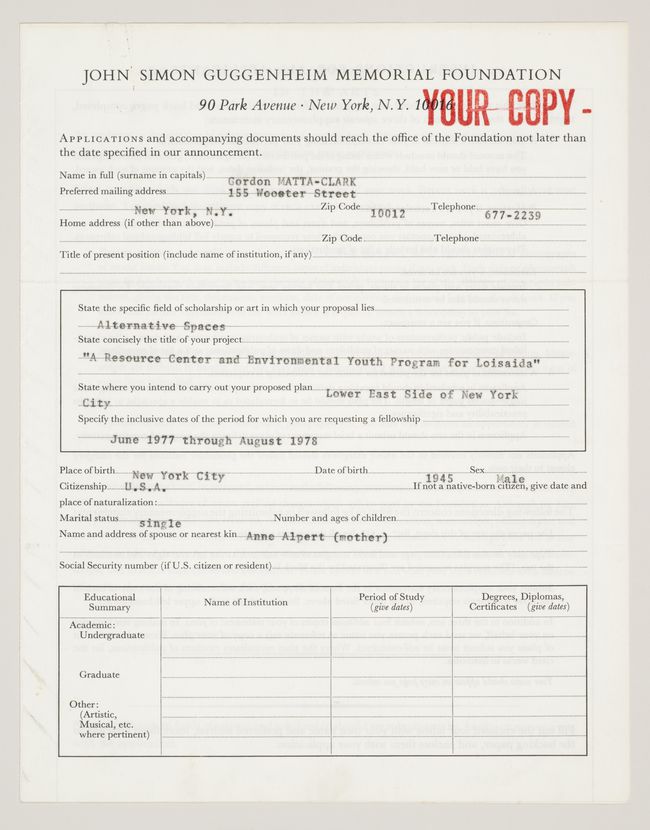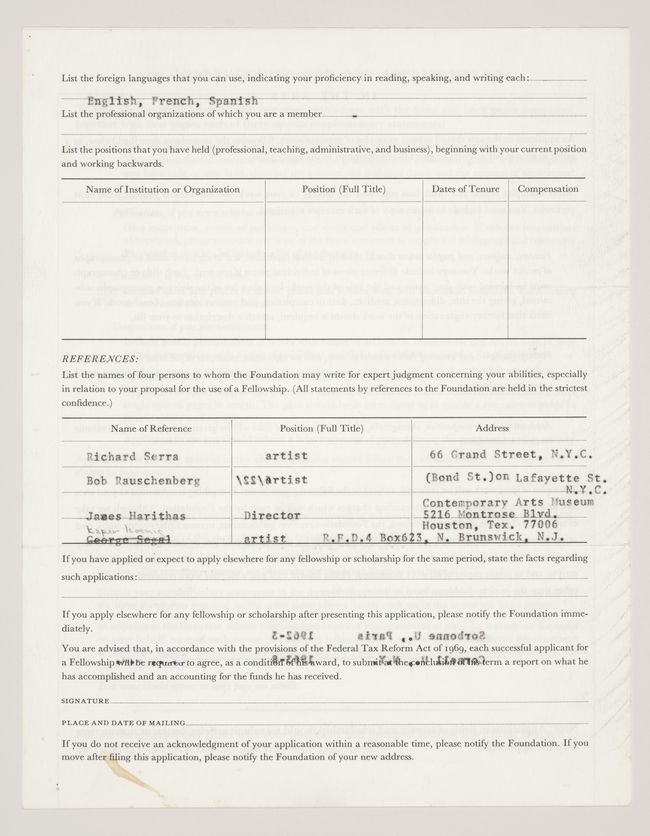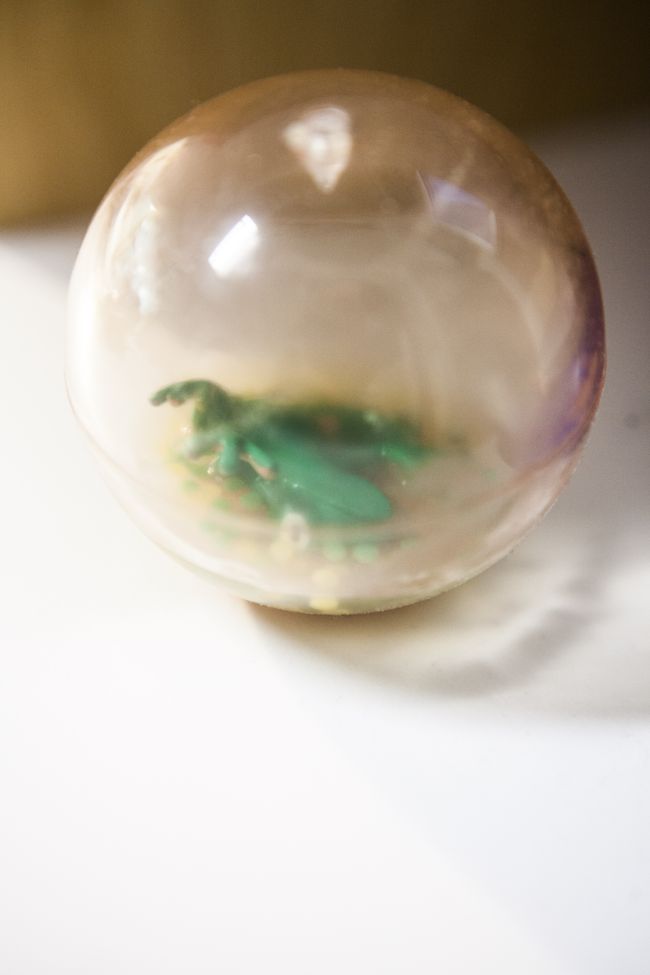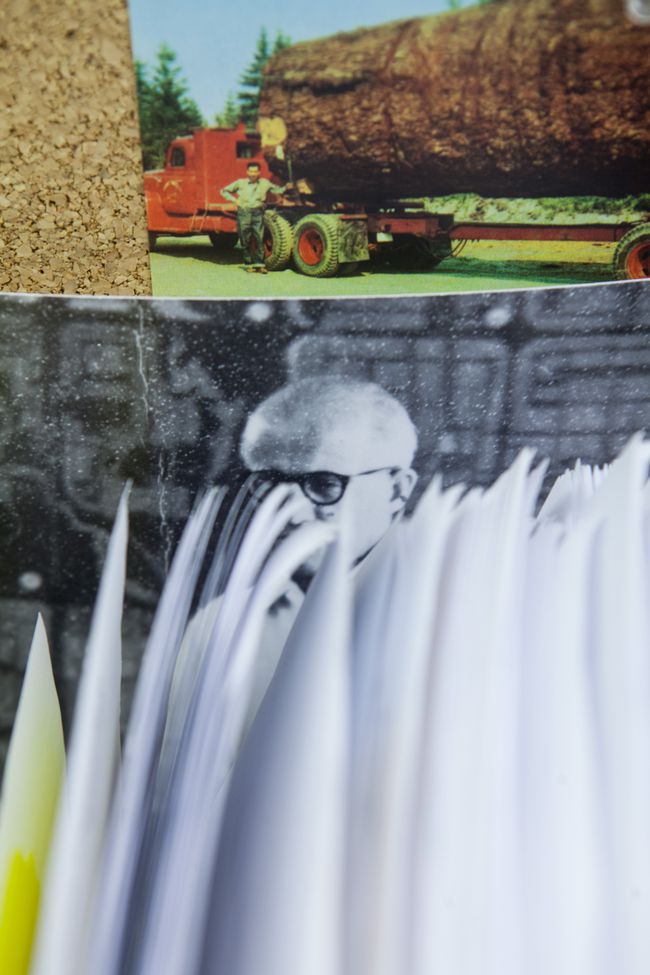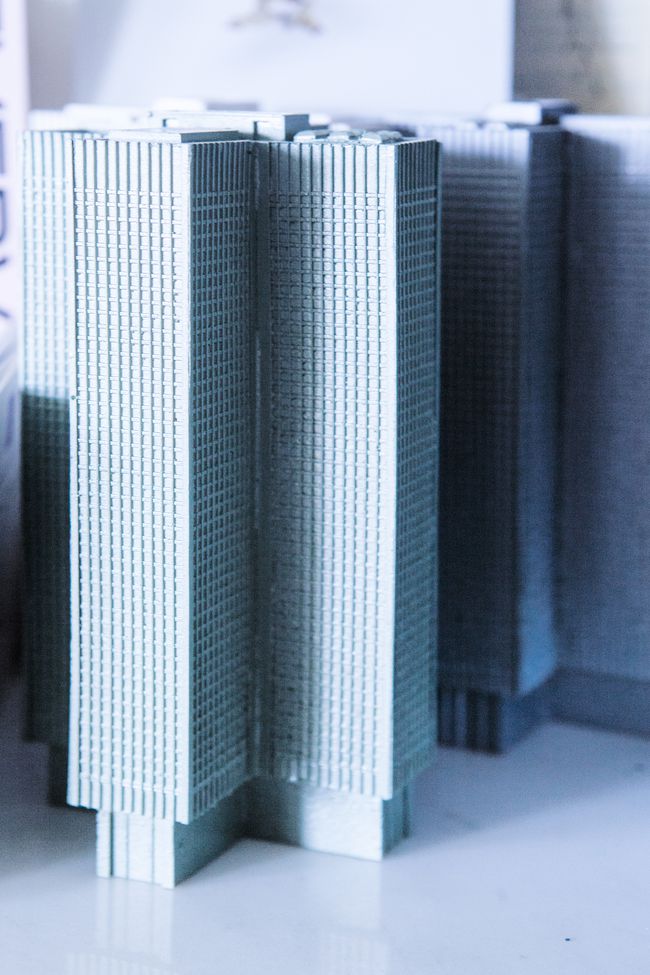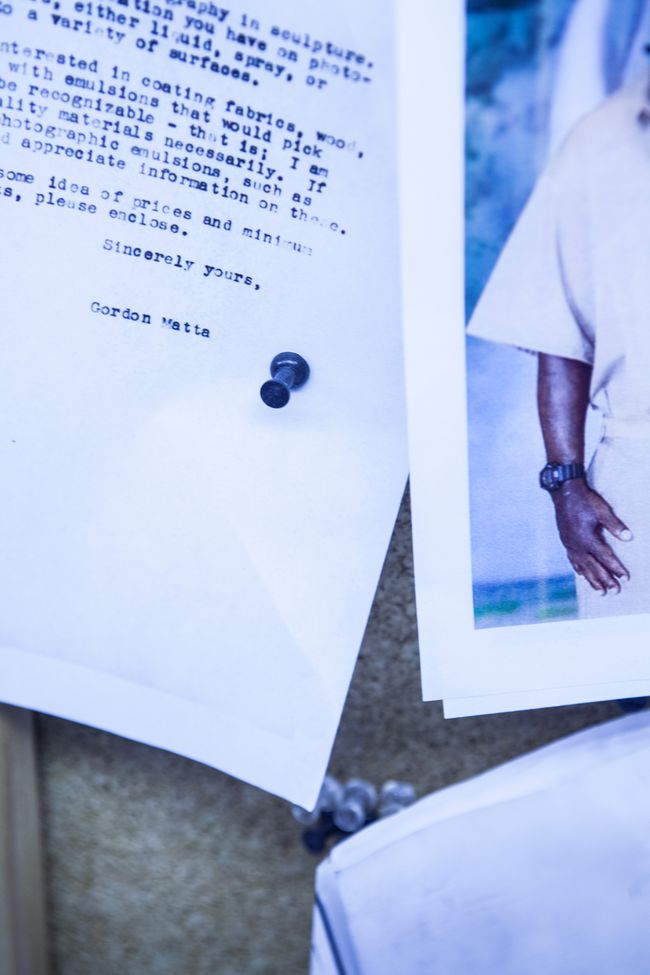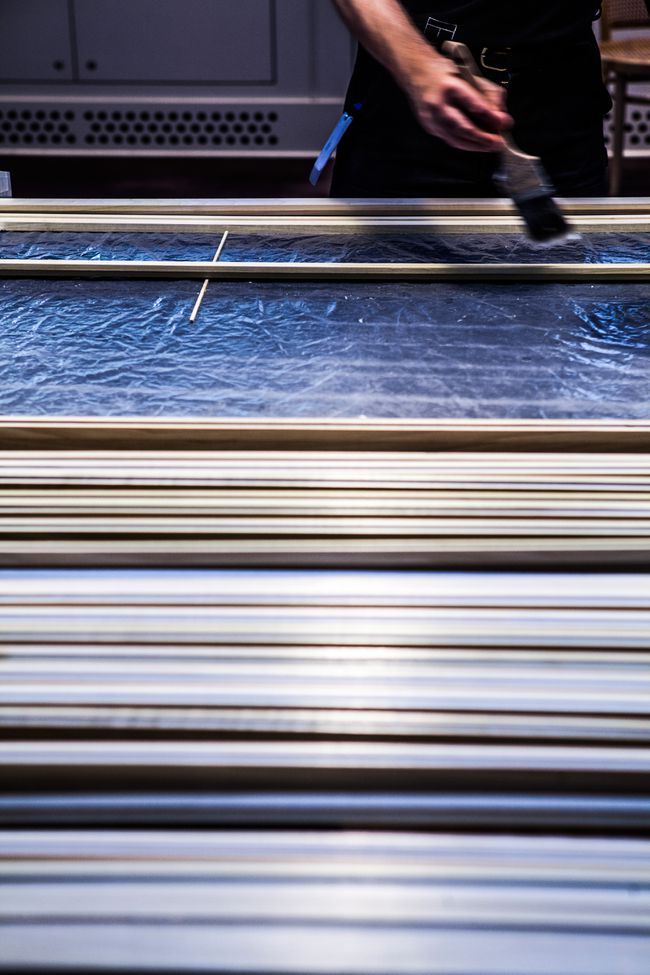I could reinvent myself
An exercise in imagining new institutions marked by stringent limitations on their structures
Coinciding with the launch of SKWAT Aoyama, a temporary installation by a group of designers, artists, curators, and book sellers in one of Tokyo’s main retail districts themed around The Museum Is Not Enough, we are republishing the book’s last chapter.
In 1976, Gordon Matta-Clark applied for a Guggenheim Foundation fellowship with a proposal for a resource centre and youth program on the Lower East Side of New York City. The idea was to secure a derelict building. The process of doing so is the first stage of work he describes: navigating property and tax structures, renovating the building, outfitting the interior. The building would then become a site for programming. Participants would learn skills and enact a new kind of neighbourhood renewal. Matta-Clark’s practice would absorb these exchanges, expanding beyond the “personal and metaphorical treatment of the site,” in his words.
The application swings almost haphazardly from too-practical detail to conceptual rationale. It clearly fits within Matta-Clark’s overall project, but it seems both to touch down from some other plane and to construct answers to pressing urban needs from the most grounded observations. It reads as very possible, but opens up, graciously, toward an unknown resolution. It is an instructive example of a plan.
A museum’s mission is always good, but the question is how you interpret that mission. What is the structure you put in place? And when do you need an entirely new one?
In a series of events called Come and Forget, the CCA invited writers and critics to propose a fruitful act of mass amnesia. In one of them, the curator Chus Martínez suggested forgetting culture. We think of everything in dialectics, she explained. In our present, we are locked into institutional stances and anti-institutional stances, both of which are ultimately institutional stances. We have found an answer to the baggage of the institution and its collection in humble, bottom-up practices that challenge historical heritage, or in mechanisms like temporary display and public programming. But alternative institutions are still institutions.
To really think differently, she suggests, you have to inhabit another persona—you have to become a strange animal, like Isabella Rossellini has done in her Green Porno relationships with insects, or like science is constantly pushing to do. You have to disentangle yourself from the idea that the dialectic between institution and anti-institution will spit out something better. You have to reorganize yourself, put yourself outside, nowhere.
Inspired by this challenge, the following fictional grant applications for a few new institutions revolve around imposing new restraints on institutional structures.
Application 1: TTTNCTB (The Thing that Never Came to Be)
TTTNCTB collects architectural projects, techniques/technologies, and materials that became obsolete, never lived up to their promises, or were never implemented, for any reason, in order to build counter-readings of why we are where we are.
The physical location is not crucial. TTTNCTB could be anywhere storage is available for a low cost. As objects collected may be hazardous or toxic, attention to the quality of storage is essential. While the items TTTNCTB collects will be catalogued, and this data made available, the most important output of the institution will be the narratives that emerge around them. Therefore, the physical location will provide only storage and research space, while the real site of the institution will be the media it produces.
Project Statement
A tension associated with pursuing the experimental and unknown has always been part of the development of ideas of architecture. Architects often want to try out new ways of using materials or to create new spatial configurations. Such proposals arise within social, political, and economic contexts. Even if they are not embraced or realized, they carry in-¬depth readings of the societies and values through which they were imagined.
We live in a positivistic society that believes strongly in progress, so unrealized and discarded ideas are often overlooked. We tend to focus on successful initiatives—what we believe will be useful for our societal growth based on what worked in the past.
TTTNCTB thinks differently, believing that an idea once cast aside might convey insight into the society and the culture that decided to not realize it. TTTNCTB does not measure failure against success; rather, failure or obsolescence is a function of misguided judgments or infelicitous conditions worth looking into. Many ideas today have been shaped as much by failed projects as successful ones, a fact rarely recognized.
There are always interesting reasons why an object or concept fails or is abandoned. Many of these reasons reveal lapses of knowledge, even simple misunderstandings of constraints (time, money; biology, physics). TTTNCTB captures these reasons and shares them, both for historical awareness and to better understand what we are missing in the line of progress we now follow.
Criteria of selection are something like a rhetoric of banned ideas: the false ceilings of conference rooms with smoke stains, to determine what happened at the street level of our cities once indoor smoking was banned; the programming of the Fun Palace, to uncover what specific possible fun we may have forgotten in mythologizing its general approach; plans of palazzos, to research why we abandoned the idea of having both winter and summer bedrooms.
Summary of Project Objectives and Contribution to the Field
Often architectural ideas are narrated from inside the dis¬cipline or through a focus on the person who thought them. Rarely are they looked at in relation to material culture, technology, or environmental or medical histories, for example. Bizarrely, projects that relied on strong ties to outside conditions for their relevance and realization are isolated in structural, poetic, or biographical thinking.
This new institution proposes to start from architectural concepts and materiality to tell a different history of architecture that, from the beginning, implies a need to place objects within other areas of knowledge.
Application 2: One to One
One to One is a nomadic institution that sparks debate on urban and environmental issues with the objective to shape public opinion and policy. The institution takes the form of an international group of experts who commit part of their lives and careers to a form of collective activism.
This is an itinerant project that drops anchor for periods of up to one month in places where none of the team members have previously lived or worked. The itinerary is not predefined and will be opportunistically built following recommendations received at each stop and based on receptiveness of hosts.
Project Statement
“Like a row of falling dominos, one action triggers another,” writes the French architect Dimitri Messu in a 2011 article published in OASE, in which he describes his interaction with local communities in the reconceptualization of public space. Interaction is contingent on our acceptance of a certain degree of instability: we step out of our comfort zones in search of new perspectives, new experiences, and eventually new knowledge. This proposal seeks to experiment with the consequences of this type of instability for an institution whose objective is to fuel discussion and influence policy.
One to One understands nomadism as a condition for regeneration and as a challenge to our reliance on digital media for any form of communication. While digital technology enables us to actively engage with people, places, and events across time and geography, there are also signs that it is making us more sedentary, and the networks with which we interact more predictable.
This proposal contends that the activities of the institution can be more fruitful when algorithms do not intervene— when the internet and social media channels become irrelevant and conversations occur face to face. One to One therefore challenges conventions and acquired knowledge, both internal and external: the institution learns and evolves as it transforms the people and places with whom and with which it interacts.
Summary of Project Objectives and Contribution to the Field
The project seeks to develop a direct form of social engagement for an institution dealing with the built environment. By relying on its nomadic status and face-to-face interaction, it questions traditional notions of infrastructure, locality, and audience, and suggests a renewed centrality of oral communication and physical contact in the creation of knowledge.
Application 3: The Apartment
The Apartment preserves objects posed on thresholds of major changes in thinking. The goal of The Apartment is to slowly compose a collection of evidence of cultural transformations. Only objects at the edges of eras or practices that foresee a revolution or anticipate a shift will be included in the collection.
The Apartment is located in a locked apartment on a top floor of a generic building. A good, panoramic view will help its scientific selection committee make critical decisions. The specific location is not important, other than being relatively convenient for the committee. There is nothing in the apartment but the objects acquired, one small kitchen, a bathroom, and a comfortable meeting room.
Project Statement
The Apartment collects objects that together define a material history of conceptual thresholds, acute transitions between one way of thinking or understanding and another. The objects that stand in these thresholds may have brought about the change they mark, or they may simply represent it.
Beyond individual objects, the institution will also accumulate a significant archive of the justifications for each object’s acquisition, which itself is part of the institution’s project: a catalogue of heterogeneous histories of present and past milestones.
The objects are preserved within The Apartment’s apartment, and they are available for individual or group consultation. Although the objects are not placed on public display, they will be available for loan to other institutions that provide a compelling reason to display them temporarily.
The collection will be preserved almost as if it were private. Secrecy will enhance the value of a catalogue of objects representing critical, crucial phases of transformation of culture.
Summary of Project Objectives and Contribution to the Field
In our endless present, it can be difficult to know things have changed. Even when there are events that somehow rise to the level of our shared awareness, we are overwhelmed by the quantity of information that either supports or questions our interpretations of what is happening. Collecting one object at a time registers changes discretely, providing a means to reflect on what and how we are thinking.
In just a few acts, a few pieces of evidence that represent a shift, we can understand—with one unique gaze—our present and our past.
Application 4: Off Day
Off Day is a cultural institution open only during the day on Saturdays to both its employees and the public, with the aim of ameliorating our tortured relationship with time. It offers materials for viewing, research, and purchase assembled around a series of topics related to design and society.
Off Day will rent an apartment or office above a busy storefront on a commercial strip in a neighbourhood in a large city. It should be convenient to reach during opening hours.
Project Statement
Off Day turns a seeming lack of time—a pervasive problem for both people and institutions today—into its key parameter, in order to investigate how certain aspects of the contemporary world have actually come to be.
In the television show Downton Abbey, the Dowager Countess, played by Maggie Smith, asks a working member of her fading aristocratic family, “What is a weekend?” While her imperious naiveté is played for laughs, Off Day finds significance in her question. Weekends were originally about boundaries (religious or economic), but we’ve willingly bought into a world with fewer boundaries and more flexibility. Now we are all poor aristocrats, responsibilities and leisure time blended into one undifferentiated block. We know this, but we remain confused about how to gain traction within this realm of possibilities. We need new frameworks to help us in approaching how we plan and conceive of time.
Off Day does not mourn a Saturday dedicated to pure leisure; instead, it accepts that Saturday is a good day to chase down new perspective on what’s around us, while recognizing that defined time and space are required to do so. It formalizes the impulse to go to somewhere edifying, like a museum, on a weekend afternoon, but it asks visitors’ participation in a radically open frame—to think and even to work, but in another way. Off Day’s structure forces new modes of institutional production and interactions. There’s not enough time for its staff to unfold an agenda or to engineer encounters in the ways institutions typically do.
During the week and on Sunday, Off Day is a storage facility for whatever its staff and public leave behind. On Saturdays, it is a collective site for investigating topics its curators are preoccupied with, supported by the insights and curiosity of those who step inside. Some days will necessarily be less interesting than others. For the first month of a new project, Off Day might operate as a meeting space and bookstore, exhibiting and selling books and objects of research that its curators are reviewing. It is the joint responsibility of the curatorial team and the visitors to make Off Day a nice place to work, or just to stop in, every week.
Summary of Project Objectives and Contribution to the Field
Off Day forces its curators and supporters to face hard numbers that are not budgetary, but human. It looks at how our world has been organized in a way that analogizes today’s disciplinary and planetary problems—ones that aren’t solved by throwing money at them, but require new ways of grappling with how we act, how we progress, what we need around us to do work, and how we decide when something is worthwhile to do at all. It provides a venue for working out how we might actually do something when we accept we can’t do everything.
Application 5: The P.O.M.M.E. Institute
The P.O.M.M.E. Institute is dedicated to research on the physical environment generated through a focus on seemingly irrelevant things.
The location is irrelevant. The character of the place has to be completely ordinary. The presence of the institute will be discreet. Maintaining this unremarkable quality may require adjustments to the institute’s physical appearance. A small plaque will be located at the entrance, engraved with the following: “Non contemnenda quasi parva sine quibus / magna constare non possunt” (St. Jerome)1
-
Quoted in Lynn White, Jr., Medieval Technology and Social Change (Oxford University Press, 1964, viii—itself a valuable example for the institute’s methods of study. ↩
Project Statement
Inspired by Paul Cézanne—“Avec un pomme, je veux étonner Paris!”1—the institute will concentrate its attention not on the apparent relevance of the topic of its investigation (what), but on the way (how) each line of research will be developed.
Through this study, the institute will not only develop new models of investigation but at the same time will project light on larger issues. In doing so the institute will offer new perspectives on the contemporary world.
The institute’s definition of irrelevance depends on context and historical moment. In order to escape the predominant thinking of a certain period, the observation point could be moved back and forth in time. It is hoped that the combination of an unalignment with the contemporary and with the hierarchies/values of a specific moment will provide freedom for open inquiries.
It should be restated that it does not ultimately matter exactly what the institute researches. The ambition is not to make the irrelevant relevant again, or to draw out why a particular thing is not relevant, but simply to find a starting point—an excuse—that allows an unconventional approach, which will generate new perspectives.
-
Quoted in Gustave Geoffroy, Claude Monet, sa vie, son temps, son œuvre (Paris: Éditions Macula, 1980), 328. ↩
Summary of Project Objectives and Contribution to the Field
The P.O.M.M.E. Institute aims to create conditions for open investigations on the contemporary physical environment. It operates from the premise that the environment is a way to look at our society, and vice versa, and that insignificant things are shaped by and reflect larger assumptions.
